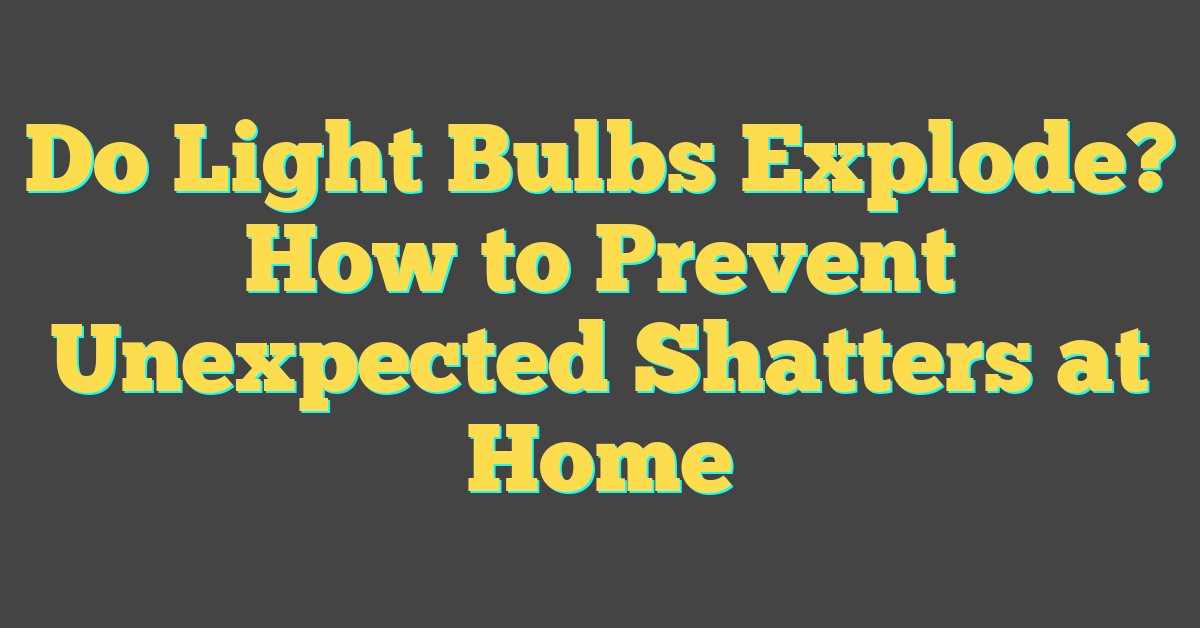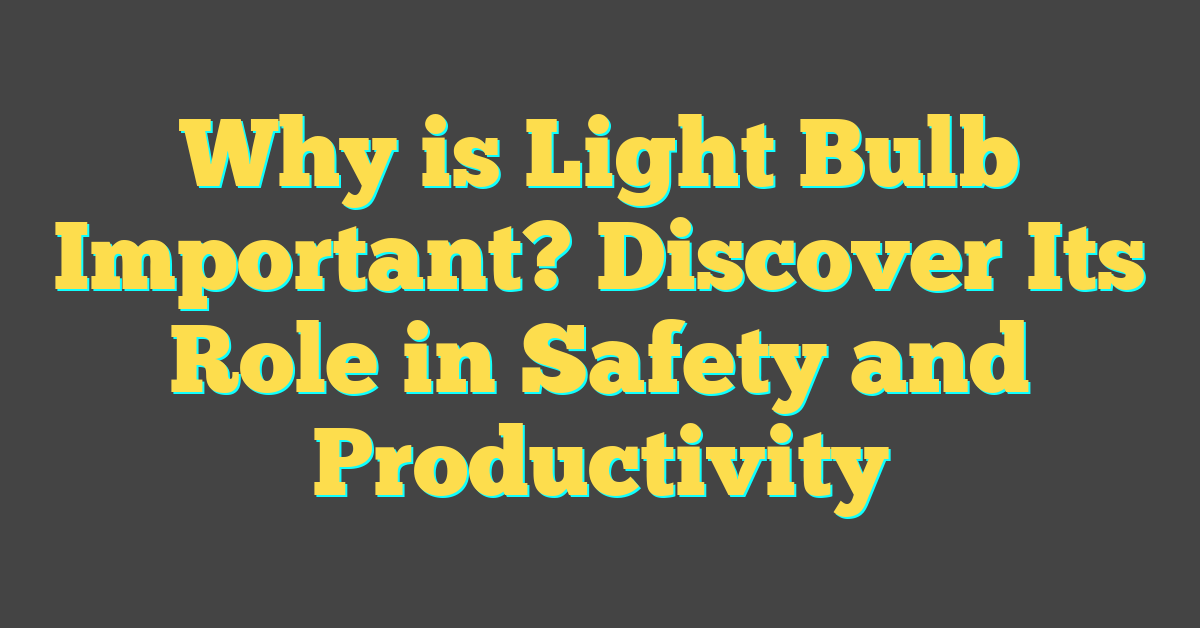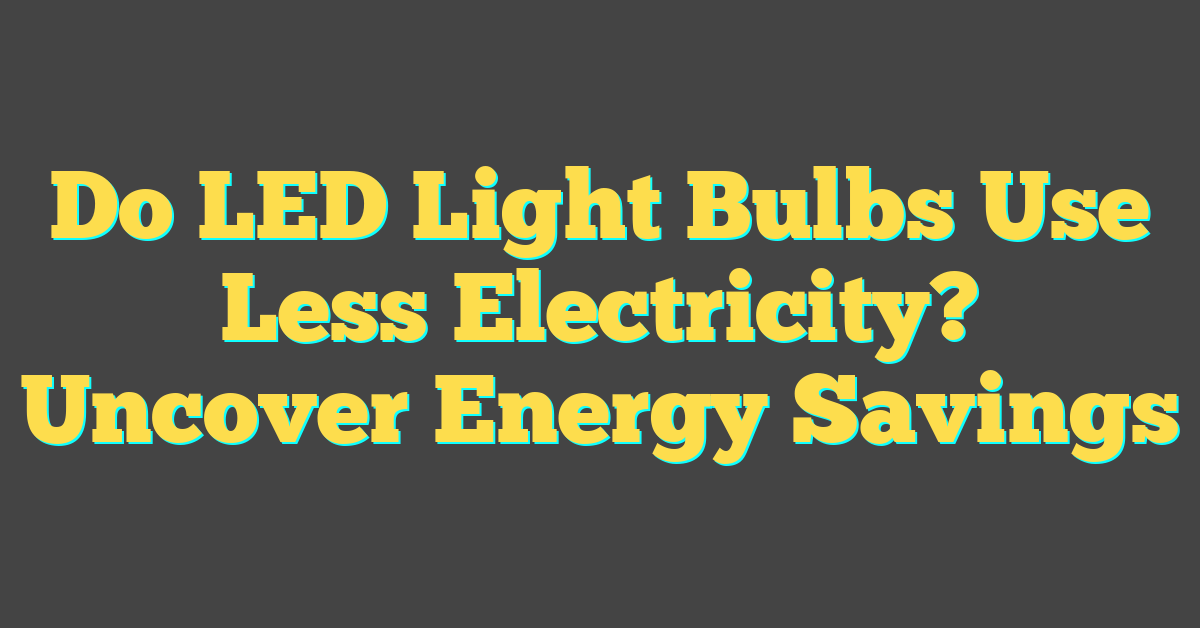Ever wondered if you can take that cozy indoor lighting vibe to your backyard or patio? You’re not alone. Many folks want to know if their favorite light bulbs can brave the great outdoors.

The truth is, not all bulbs are built for outside life. But don’t worry, you’re about to find out which ones can handle the elements and how to choose the perfect outdoor-friendly bulb.
Benefits of using light bulbs outside
Outdoor lighting can transform your space in more ways than one. Delving into the advantages, enhanced security might top your list. A well-lit home deters potential intruders who prefer the cover of darkness. Strategic placement of bulbs can illuminate dark corners and pathways, making it tough for anyone to sneak around unnoticed. It’s a simple step that could significantly bolster your home’s defense.
Aside from security, the aesthetic appeal shouldn’t be underestimated. There’s something about the warm glow of outdoor lights that adds a welcoming touch to your abode. Whether it’s soft light cascading through your garden or the cheerful twinkle of patio strings, lights add depth and drama to your outdoor living spaces.
Using light bulbs outside also extends the functionality of your exterior areas. Imagine hosting a twilight barbecue or enjoying a late-night dip in the pool. With proper lighting, these activities needn’t stop once the sun goes down. Good illumination ensures that your outdoor fun isn’t limited by daylight hours.
- Increased visibility
- Reduced trip hazards
- More time spent outdoors
Your choice of outdoor bulbs can also reflect your commitment to environmentally conscious living. LED bulbs, for instance, consume less energy and have a longer lifespan than conventional bulbs. This means less frequent replacements and more savings on your energy bills.
Keep in mind, though, that such benefits hinge on proper installation and maintenance. It’s imperative to keep fixtures clean and to replace bulbs as needed to maintain optimum performance and energy efficiency. Remember to select bulbs rated for outdoor use to ensure they can withstand the elements and deliver on these advantages without a hitch.
Factors to consider before using light bulbs outside

Before you brave the elements to give your outdoor space that warm welcome, you’ve got to keep a few factors in mind. Outdoor lighting is not as simple as screwing a bulb into a socket. Planning is key.
Weather Resilience is your top priority. Outdoor bulbs need to be tough enough to withstand rain, snow, and extreme temperatures. Look for bulbs rated for outdoor use—these will often have a sturdier construction and watertight seals.
Then there’s the Brightness and Color Temperature. While it’s tempting to go for the brightest option, consider the purpose of your lighting. Do you want a soft glow for ambiance, or do you need clear visibility for security purposes? Also, take into account the color temperature. A cooler temperature may suit security lighting, whereas a warmer tone can enhance the aesthetic appeal.
Energy Efficiency is another major aspect you don’t want to gloss over. LED bulbs might be more expensive upfront, but they’ll save you money in the long run. And let’s not forget your green footprint—LEDs are the friendliest option for the environment.
Consider the Fixture Compatibility. Not all light fixtures are designed for outdoor use. Ensure your fixtures have proper ratings for outdoor exposure—this information is usually listed as IP ratings that inform you about the level of protection against elements.
Lastly, think about Control and Automation. Wouldn’t it be nice if your outdoor lights turned off with the sunrise and on when the sun sets? Investing in timers, motion sensors, or smart lighting systems can offer both convenience and efficiency.
When you’ve thoroughly considered these factors, you’ll be much closer to achieving a well-lit, functional, and inviting outdoor space that reflects both your needs and personality. Just remember, regular maintenance is key to keeping your lights shining bright and efficient for longer periods, so don’t neglect that aspect either.
Types of light bulbs that can be used outside
« What Light Bulb Is Made Of: Unveiling Hi-Tech Materials & Eco Advances
How Big Are Light Bulbs? Discover Sizes That Transform Spaces »

When you’re ready to light up the night sky — or at least your backyard — it’s key to pick the right type of lightbulbs. Your outdoor space deserves not only to be illuminated but to be done so efficiently and in style.
Incandescent Bulbs are the old-school choice that might remind you of classic string lights at a backyard barbecue. They can operate in cold weather, which is great for year-round festivities. Just check for bulbs rated for outdoor use to ensure they can handle the unpredictability of the weather.
For the energy savers out there, LED Bulbs are your go-to. Not only do they sip electricity compared to their ancestors, but they also have a significantly longer lifespan. You’ll often find them with features like dimming capabilities and a broad range of color temperatures to set the perfect mood for your outdoor area.
Halogen Bulbs deliver a crisp, white light and are more energy-efficient than incandescent bulbs. These are fantastic for spotlights or security lights due to their bright and focused beam. Ensure they’re safe for outdoor use, and you’ll have a clear and well-lit space.
CFLs (Compact Fluorescent Lamps) might take a moment to warm up, but once they do, you get a consistent and cost-effective light. Since they’re sensitive to extreme conditions, look for specifically designed outdoor CFLs that can brave the elements.
- Solar-Powered Lights are gaining traction, providing an off-the-grid solution. Install these in sunny locations, and they’ll take care of themselves, turning on as dusk falls and off as dawn approaches.
Remember to match the bulb to your fixture for a perfect fitting; it’s not just about screwing it in. And when you’re experimenting with different types, think about how they’ll coexist with your outdoor decor, and choose lights that complement your home’s overall vibe. With the right choice, the transition from daylight to your personalized glow will be seamless.
How to choose the right outdoor light bulbs

When you’re getting ready to illuminate your outdoor space, picking the right light bulbs isn’t just a matter of style; it’s about functionality, efficiency, and safety. There’s a bunch of factors you’ll need to consider.
First up, think about the bulb’s wattage. Outdoor fixtures are designed to handle specific wattage ratings, and pushing these limits can be a fire hazard. Check your fixtures’ specifications to ensure you’re on the safe side.
Next, consider the color temperature. Light color is measured in Kelvins, with lower numbers giving off a warmer, cozier light and higher numbers resulting in a cooler, crisper illumination. For outdoor settings, you might prefer warmer lights for relaxation areas and cooler temperatures for security lighting.
Here’s the key: Look for bulbs labeled “outdoor”. They’re built to withstand the elements, from rain to sun to wind. Not all bulbs are equipped for the great outdoors, so snatch up those that are.
Don’t forget about energy efficiency. LEDs and solar-powered lights are your best bets for keeping energy costs down over time. They come with the added benefit of longevity, which means fewer replacements and less maintenance.
And here’s a quick checklist for you:
- Ensure the wattage matches your fixture
- Opt for outdoor-rated bulbs
- Choose the right color temperature
- Aim for energy-efficient options like LEDs
Don’t worry too much about matching every outdoor light with the same color temperature or type. Variety can define different areas of your yard and create a dynamic atmosphere. Just make sure that wherever you install your bulbs, they’re the right fit for the fixture and the job you want them to do. Remember, your outdoor space is an extension of your home. It deserves the same attention to detail and a personal touch that reflects your style and meets your needs.
Tips for installing and maintaining outdoor light bulbs

When you’re setting up outdoor lighting, there are several tips to keep in mind that’ll not only make the installation process smoother but also ensure long-term performance and durability.
Firstly, read the instructions that come with your outdoor light fixtures and bulbs. This might seem like a no-brainer, but it’s easy to overlook and can lead to avoidable mistakes. Pay attention to any wattage or voltage requirements to avoid overpowering the fixture, which can result in a shorter bulb lifespan or, worse, an electrical hazard.
Be sure to turn off the power at the breaker box before commencing any electrical work. Safety’s always the top priority and you don’t want to risk a shock. Once the power is off, installing the bulb should be straightforward, but always ensure it is securely fitted into the socket to avoid moisture intrusion, which could damage the bulb or socket.
Weatherproofing is essential. Check that your fixtures are rated for outdoor use and check for seals or gaskets that help prevent water damage. If you’re installing spotlights or floodlights, angle them away from the direct elements if possible. You could use shields or hoods to offer extra protection from the rain and wind.
Regarding maintenance, keep an eye out for any signs of wear and tear. Rust, corrosion, or cracks can lead to water entering the fixture, which can compromise the entire setup. Regularly clean your light fixtures to remove debris—especially after a heavy storm—this will help maintain your lighting’s brightness and reduce the risk of overheating.
If you’re using LED bulbs, they’ll last a long time, but that doesn’t mean they’re invincible. Check the LED drivers periodically, as they can be the first component to fail, especially in harsh outdoor conditions.
Be mindful of the nature surrounding your outdoor lights. Growing plants can sometimes obscure or even strangle fixtures. A quick trim every now and then can prevent any natural elements from causing electrical faults or limiting the effectiveness of your lighting.
With these simple installation and maintenance tips, you’ll enjoy a vibrant and welcoming outdoor space that’ll not just impress your neighbors but serve as a cozy retreat for those long, leisure-filled evenings.
Conclusion
You’ve got all the know-how to keep your outdoor lights shining bright and safe. Remember, taking the time to get it right from the start will save you from headaches down the road. Don’t forget to keep an eye on those fixtures, give them a good clean now and then, and make sure they’re not getting into a tangle with Mother Nature. With a little care and attention, you’ll not only light up your outdoor space but also extend the life of your bulbs. Here’s to many evenings of perfect, hassle-free illumination!
Frequently Asked Questions
What is the key to proper outdoor light bulb installation?
The key to proper outdoor light bulb installation is to carefully read the instructions and ensure you are using bulbs with the correct wattage and voltage for your specific fixtures to prevent electrical hazards.
How do I protect my outdoor light bulbs from weather damage?
To protect outdoor light bulbs from weather damage, use weatherproof bulbs and fixtures, check for signs of wear and tear, and ensure all seals are intact to prevent water intrusion.
What maintenance tasks are recommended for outdoor light bulbs?
Regular maintenance for outdoor light bulbs includes cleaning the bulbs to avoid dimness, checking LED drivers, and inspecting for damage such as cracks or faulty seals.
How often should I check my outdoor light bulbs and fixtures?
It is recommended to check your outdoor light bulbs and fixtures at least once a season, or more frequently if they are exposed to harsh weather conditions or high usage.
Can the surrounding environment affect outdoor light fixtures?
Yes, surrounding plants and nature can affect outdoor light fixtures by obstructing light or potentially damaging them. Trim any plants that might grow too close to the fixtures to prevent such issues.




